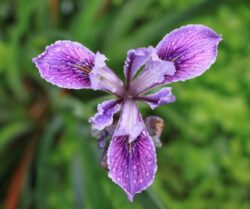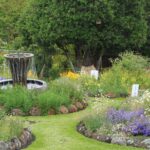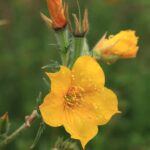Lot size: 1,100 sq. ft. front and 1,500 sq. ft. back garden, 95% native
Garden Age: Garden was installed in 2016
Years on the Bringing Back the Natives Garden Tour: 5
Showcase Feature
When Danny and Eugene bought their house in 2016 they knew the thirsty lawns and sprawling junipers had to go. The garden they designed and installed themselves transformed the space into a delightful patchwork of moss-rock-lined beds brimming with more than 200 species of California native plants and a wide variety of edibles.
 Many of the plants in this meticulously curated garden were grown from seed by Danny—ask about his propagation techniques.
Many of the plants in this meticulously curated garden were grown from seed by Danny—ask about his propagation techniques.
This vibrant garden showcases everything a plant lover could hope for: colorful flower beds—including a gorgeous wildflower meadow—a flourishing vegetable garden, a cozy seating area (drop down and take a rest!), two fountains, and even a charming quail aviary. With a 99% native plant palette, this garden shows how beauty and sustainability go hand-in-hand.
Danny and Eugene’s garden is a testament to how native plants can transform urban spaces into thriving, wildlife-friendly retreats. Whether you’re a seasoned gardener or just starting out, you’ll find inspiration, beauty, and plenty of ideas to take home.
Come for the plants, stay for the stories, and leave with a heart full of ideas and maybe even a seed packet or two for your own native garden!
Other Garden Attractions
• Native Lawn Inspiration: See the water-wise wonder of Lippia repens (Phyla nodiflora), a soft, low-growing ground cover with lavender-pink blooms that’s tough enough to handle foot traffic, while delighting bees and butterflies.
• Seed Enthusiasts, Rejoice! Purchase untreated, organic, and non-GMO native seeds, lovingly grown in this garden and hand-packed by the hosts. The seeds even come with water-resistant labels that double as plant tags! Explore Danny and Eugene’s seed collection at CaliforniaNativeSeeds.com.
• Wildlife Haven: From the soothing splash of fountains to the lively chirps of quail, this garden burbles and warbles with the sounds of nature. Keep an eye out for any of the multitude of fauna, insects, and birds that visit this residential oasis for wildlife.
• Vegetable Delights: Feast your eyes on the productive veggie patch and draw inspiration for your own edible garden.
Gardening for Wildlife
Our native and nocturnal gray foxes have been seen in the garden, silently padding in the moonlight. Anise swallowtail butterflies flutter among the yampah, their native host plant, where they lay eggs, ensuring the next generation of these beautiful pollinators. Monarch butterflies, whose population is in steep decline, also frequent the garden, drawn to the abundance of native milkweed carefully cultivated to support their life cycle.
Scrub jays, ever bold and curious, chatter noisily from the elderberry bushes, occasionally swooping down to investigate or forage. Hummingbirds zip between the vibrant red blooms of penstemons and hummingbird sage, their iridescent feathers catching the sunlight. Slender salamanders shelter under cool, damp rocks or logs; these shy, elusive creatures are a sign of a healthy soil ecosystem.
 Alligator lizards bask in sunny spots, their calm demeanor and flickering tongues adding a prehistoric charm to the landscape. Meanwhile, mason bees industriously buzz around, contributing to the garden’s fertility as they pollinate plants with expert precision.
Alligator lizards bask in sunny spots, their calm demeanor and flickering tongues adding a prehistoric charm to the landscape. Meanwhile, mason bees industriously buzz around, contributing to the garden’s fertility as they pollinate plants with expert precision.
Every corner of Danny and Eugene’s garden hums with life, a vibrant example of how planting with wildlife in mind can create a dynamic and sustainable sanctuary.
Keystone species in this garden (watch this talk by Doug Tallamy!)
This garden isn’t just beautiful—it’s a lifeline for wildlife. Keystone plants like oak, manzanitas, sages, lupines, buckwheats, goldenrods, and elderberry provide essential habitat and food for caterpillars, and places where butterflies and moths can lay their eggs. Fun fact: baby birds depend on caterpillars for survival, making the plants listed above—and other keystone plants—critical for healthy ecosystems.
Green Home Features!
Danny and Eugene don’t just care for their plants—they care for the planet. With solar panels, a graywater system, and even a bidet to conserve water and trees, their home reflects their commitment to sustainability.
Talks in the Garden
11:00 and 2:00 “Worms Eat My Garbage” by Mona
Danny and Eugene have been vermicomposting—using worms to turn their kitchen scraps into beautiful, rich compost—in their garage for many years. In addition to the benefits they and their garden have reaped from the worms’ diligent work they have kept a tremendous amount of food waste out of the landfill. (Now, our food scraps need to go into the green waste bin—but it’s way better for our gardens, and cheaper for society, if we just compost our own food scraps at home.)
Come see what beautiful soil amendment you can make at home, yourself, for free!
Video of Eugene and Danny’s garden
“Showcasing the early bloomers: Lilacs, manzanitas, currants, and wildflowers” by Eugene Shabelyanau and Danny Galindo























